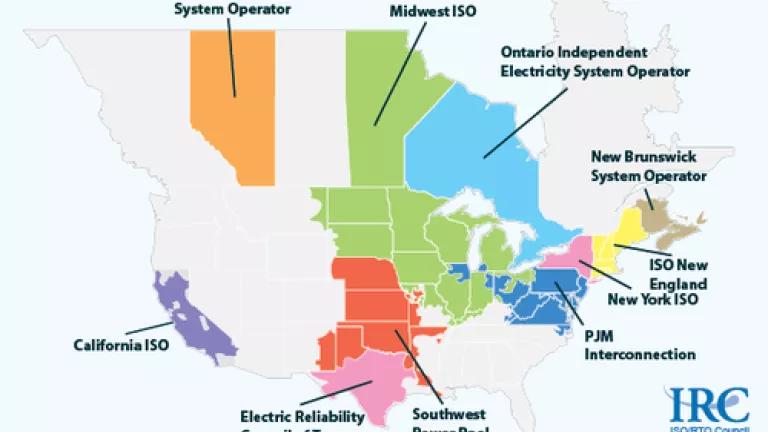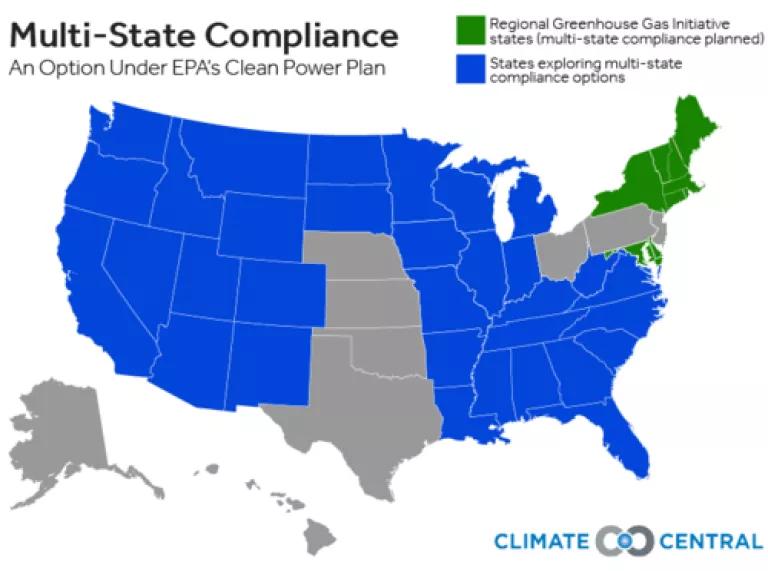Earth to Mitch McConnell: States are already working together to cut carbon--and didn't need your permission

By now, we should all be used to Senator Mitch McConnell (R-KY) concocting dubious arguments intended to slow our progress in cutting dangerous carbon pollution. But as a native Kentuckian, born and raised on a horse farm in the bluegrass, I don't think I'll ever be. To add insult to injury, McConnell's latest diatribe distracts from one of the holiest of days in my home state: For the 141st time on the first Saturday in May, the Kentucky Derby cometh. The Senator's time would be better spent trying to pick a winning horse rather than lobbing more longshot attacks at the Environmental Protection Agency.
His latest ploy to muck up the EPA's Clean Power Plan to cut carbon from power plants is to claim that states will need Congress's permission before they can collaborate to achieve vital emissions reductions at the lowest cost to consumers. Before getting into the fatal flaws in his latest legal argument, let's clarify what a multi-state approach to compliance really means, and why it's a smart approach that states are increasingly attracted to. Then, we'll take a quick look at what states are already doing on this front.
What does "multi-state" mean, anyway?
As states have begun to explore options for meeting their reduction targets, many have come to see the advantages of cooperation in plan design and implementation. Some regulators were initially intimidated by the prospect of trying to hammer out a regional agreement under the timeframe contemplated by the proposed rule. But participants have discovered that market-based, multi-state approaches can take many forms, from already built-out, regional programs like the Northeast and Mid-Atlantic's Regional Greenhouse Gas Initiative (RGGI), to less administratively formalized but still relatively straightforward "mass-based" plans that limit the total amount of carbon pollution power plants in a state can emit and allow power plants, as part of their emissions reduction strategies, to trade carbon credits with other states that adopt comparable plans. (Essentially, these states will adopt a common carbon currency that sources can trade as necessary and ultimately use to demonstrate compliance with the plan's emission limits). As state regulators have begun to dig into these options, many are increasingly interested in multi-state paths forward--and with good reason.
Multi-state solutions are less expensive and boost reliability
As the map of the country's transmission grids (below) indicates, electricity doesn't stop at state borders, and neither does the pollution associated with it. Instead, the nation's power grid is divided up into a number of regional power pools. This large network allows utilities and consumers better access to affordable electricity than if each state, or even each city, depended solely on its own power plants.
Since electricity is generated and flows across states within those regions, as well as between regions, a lot of good can come from maximizing consistency across state lines. Multi-state, market-based programs also have a great track record. States and power plant owners alike have seen for themselves substantial cost-savings under programs like RGGI and the EPA's interstate acid rain programs.
Multi-state compliance options available in the Clean Power Plan can help states work within the reality of our nation's transmission grids. As this map of them shows, electricity doesn't stop at state borders.
But you don't have to take our word for it. Many of the larger power companies that will be tasked with meeting CPP reduction targets have been supportive of regional approaches, in part, because they have power plants and transmission infrastructure in more than one state. And, as numerous modeling exercises have demonstrated--including one by the operator of the largest transmission grid in the western hemisphere, PJM--multi-state approaches significantly cut compliance costs when compared to state-by-state approaches. (In PJM's analysis, multi-state was roughly 30 percent cheaper.) That's because states can share both power and compliance responsibilities. Similarly, modeling done by the Midwest's transmission grid operator, known as MISO, found that a multi-state approach could save consumers nearly $3 billion annually, relative to states going it alone. Multi-state, market-based strategies also increase grid reliability. By expanding the universe of carbon reduction options beyond what's available in any single state, states and power companies have more flexibility to stay on the necessary glide path to 2030 emissions reductions while alleviating pressure on any individual facility that may be needed in the near term as we transition to cleaner, more efficient resources. (While, simultaneously, offsetting those emissions with cleaner power sources elsewhere in the region.)
What have the states already been up to?
As the map below illustrates, many states across the nation have either already implemented or are actively discussing multi-state approaches to cutting carbon from power plants.

The vast majority of states are either exploring multi-state CPP compliance options or already enrolled in them, as this map, from an article on Climate Central, illustrates. (map courtesy of Climate Central.)
Here's a quick rundown of some of those efforts:
- The Regional Greenhouse Gas Initiative: The nation's first multi-state, market-based program began to take shape more than a decade ago, and power plants in these nine Northeast and Mid-Atlantic states have been buying allowances to cover every ton of carbon they emit since the first RGGI auction started, way back in October 2008. A recent analysis found that, so far, in addition to cutting carbon, the states' reinvestment of allowance revenues in energy efficiency and renewable energy will generate more than $2.9 billion in energy-bill savings for the region's homes and businesses.
- Out West: For years, California has been a trailblazer in cutting carbon pollution from all sectors, and has recently linked up with carbon markets in Quebec and Ontario. A few states over, Utah was recently selected as a winner to receive modeling support from the National Governor's Association to assess various compliance options, including multi-state approaches. (The other winners were Pennsylvania, Michigan, and Missouri.) And an effort headed by former Colorado Governor Bill Ritter's Center for the New Energy Economy at Colorado State University is convening western states to explore such options. That dialogue will be further informed by this excellent piece just released by the Cadmus Group on multi-state approaches in the West.
- Midwest: The Midcontinent States Environmental and Energy Regulators collaborative has involved states in the MISO region for some time, and a recent Bipartisan Policy Center release reinforced the cost savings and other benefits presented by a multi-state approach in the Midwest and beyond.
- PJM: In September 2014, forward-thinking utility commissioners from across the 12-state region that includes Pennsylvania and Ohio submitted a request to PJM to model regional approaches, and informal discussions regarding multi-state options are evolving.
- Southeast: Across the region, there have been a large number of forums that have addressed multi-state collaboration on the Clean Power Plan.
Why McConnell is wrong. . .again.
As reported in Politico, at an appropriations committee hearing this week, the Senator asserted that Section 102(c) of the Clean Air Act bars states from collaborating to cut carbon under the Clean Power Plan without explicit Congressional approval. He's dead wrong.
States don't need to enter "compacts" in order to cooperate in emissions trading arrangements.
Although any group of states may cooperate in designing consistent plans, each state will generally submit its plan independently. In many cases, a state will choose to include provisions in its plan to recognize carbon credits from other states and allow sources in other states to use credits from the home state. The proven RGGI program is a prime example: nine independent but coordinated plans that recognize interstate transfer of allowances. Another example is the Clean Air Interstate Rule, issued by the EPA during the George W. Bush administration. States in the eastern half of the United States adopted plans putting caps on power plant emissions of sulfur dioxide and nitrogen oxides, and allowing the trading of allowances between sources in different states.
No one suggested the need for a compact there.
In the last couple of days, some have suggested that power plant operators can't rely on these interstate emission credit mechanisms, because of the fear that a state might walk away from its commitments. But that is not a real issue. State plans to meet CPP targets will be submitted to and approved by the EPA. If a state attempted to walk away, its plan would still be federally enforceable by citizens, including by a source in another state that was relying on the state's emissions credits.
So the good news here is that the many states exploring ways to team up to meet the CPP needn't check in with Congress before continuing those discussions. Nor do they need to get Congressional sign-off before submitting multi-state compliance plans to the EPA.
After all, like Derby Day mint juleps, cutting carbon is just better when enjoyed with neighbors.

